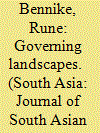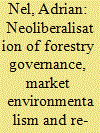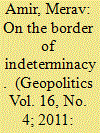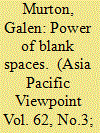|
|
|
Sort Order |
|
|
|
Items / Page
|
|
|
|
|
|
|
| Srl | Item |
| 1 |
ID:
152968


|
|
|
|
|
| Summary/Abstract |
Throughout most of human history, the topological features of landscapes have played a crucial role in the government of people and places. The hostile geographies of mountains and forests have provided zones of refuge for people fleeing expanding empires and state structures. In turn, ecological features have been employed as central markers in governmental discourse separating civilisation from the inhospitable wilderness beyond.11. Sumit Guha, Environment and Ethnicity in India, 1200–1991 (Cambridge: Cambridge University Press, 1999); and James
|
|
|
|
|
|
|
|
|
|
|
|
|
|
|
|
| 2 |
ID:
142660


|
|
|
|
|
| Summary/Abstract |
There is often a disjuncture between idealised forestry governance models which posit a ‘win-win for community and environment’ through participatory, multi-stakeholder international development discourses and interventions – and the actually existing processes and structures of natural resource government through which they are articulated. By applying, first, established theorisations of the initial territorialisation of state forestry territory, then conceptualisations of re- and de-territorialisation, derived from Deleuzo-Guattarian formulations, this paper expands on post-structuralist lines of inquiry on the political ecology of forestry to explore substantive transformations in forestry governance in Uganda. It specifically details the role that market environmentalism – the extension of market mechanisms, including carbon forestry, to natural resource governance – plays in reorienting assemblages of actors engaged in forestry governance and in changing configurations of state forestry territory.
|
|
|
|
|
|
|
|
|
|
|
|
|
|
|
|
| 3 |
ID:
108905


|
|
|
|
|
| Publication |
2011.
|
| Summary/Abstract |
Drawing on a perspective which takes into account the convergences of sovereign and biopolitical ruling apparatuses, the aim of this article is to provide a comprehensive view of the Separation Wall constructed by Israel in East Jerusalem, and, through it, of Israeli control of Palestinian East Jerusalem. Neither a comprehensive border, nor a mere barrier, the Separation Wall which is being constructed in Jerusalem operates to reinstates sovereign power in arrays of governmentality for the purpose of drawing on the ability of sovereignty to appropriate legitimacy for the territorialisation of governmentality. This article claims that these territorialised arrays of governmentality give rise to processes of racialisation, by maintaining a grip on the communities of Palestinians in East Jerusalem and sustaining them in an intermediate position, standing in the way of their full integration into the Israeli population while severing their existing connections with the Palestinians in the West Bank.
|
|
|
|
|
|
|
|
|
|
|
|
|
|
|
|
| 4 |
ID:
182692


|
|
|
|
|
| Summary/Abstract |
A variety of maps depict a usefully approximate but inexact network of roads, rails, sea lanes and other infrastructures to represent something called China's Belt and Road Initiative (BRI). And yet, for a global programme that reflects and advances Beijing's new position as a leader of international development, BRI maps remain largely imprecise and unofficial. Taking this as a starting point of critical cartography, I ask why BRI development throughout the Tibet-Himalaya region remains conspicuously blank on most maps, and what work is accomplished by such cartographic silences. In contrast to this apparent invisibility, however, the BRI is very much present in Nepal – discursively, materially and cartographically. Chinese development programmes are widely anticipated, embraced and promoted as grand and spectacular things throughout Nepal. Following this friction of representation in the case of Chinese development in Nepal, I argue that the apparent paradox between the BRI as invisible thing and BRI as promised future reveals the manifold ways in which infrastructures articulate politics and, vice-versa, how politics articulate infrastructures.
|
|
|
|
|
|
|
|
|
|
|
|
|
|
|
|
|
|
|
|
|